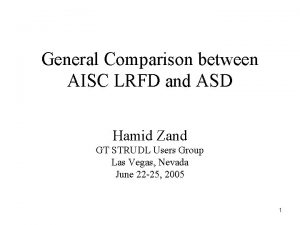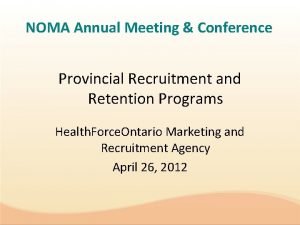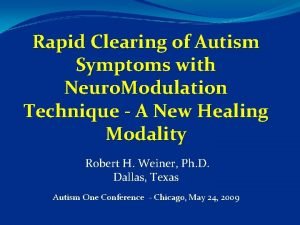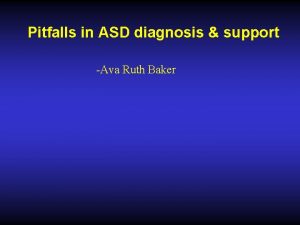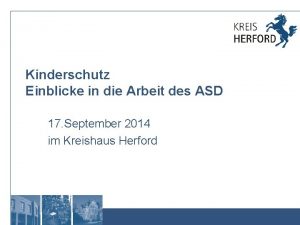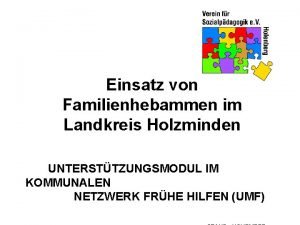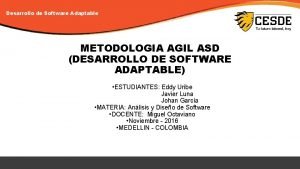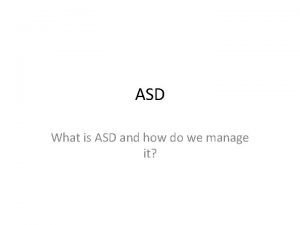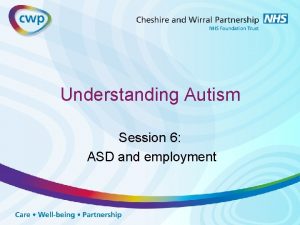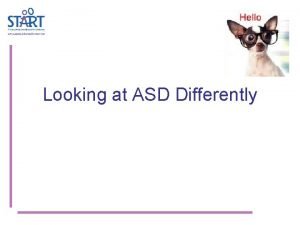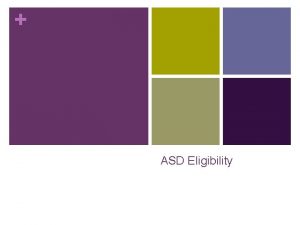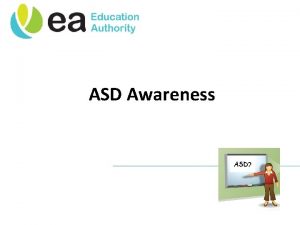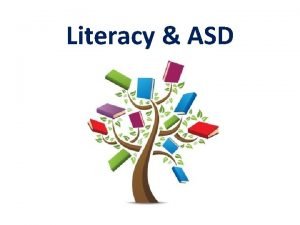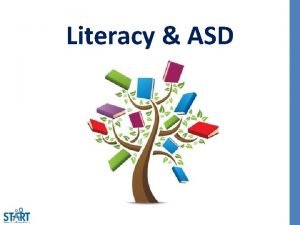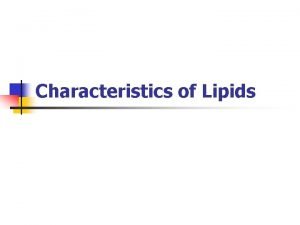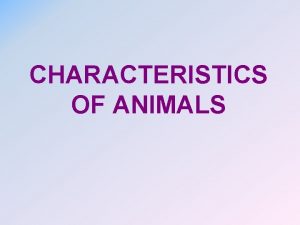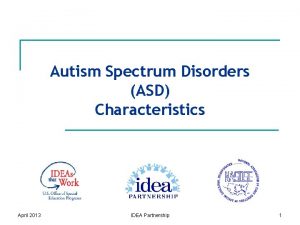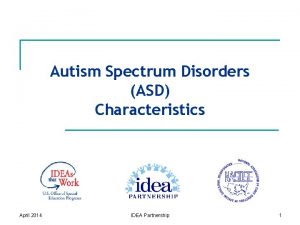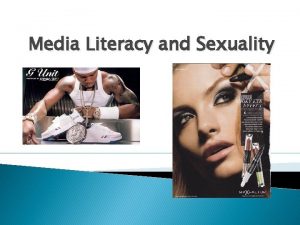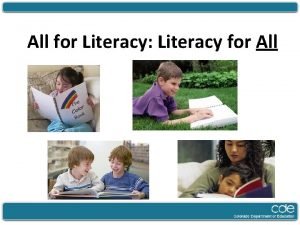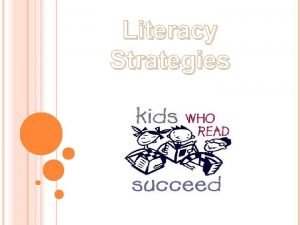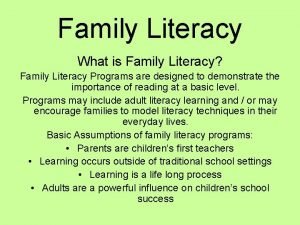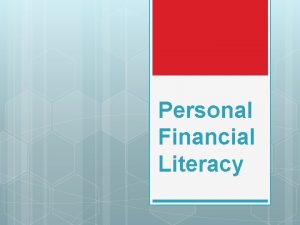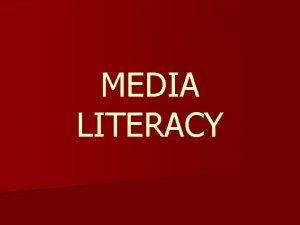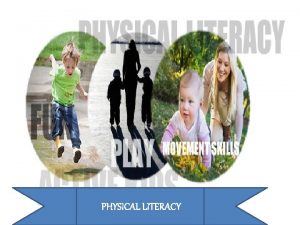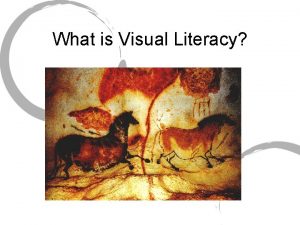ASD and Literacy ASD Literacy Initiative Literacy Characteristics























- Slides: 23

ASD and Literacy

ASD Literacy Initiative • • • Literacy Characteristics Matrix and Overlapping characteristics and integrated interventions Guiding Principles Literacy Hierarchy Literacy Intervention Analysis Literacy Strategies

Literacy: Guiding Principles (Kluth & Chandler-Olcott, 2008) • • Maintain high expectations Provide models of literate behavior Elicit students’ perspectives Promote diversity as a positive resource Adopt “elastic” instructional approaches Use flexible grouping strategies Differentiate instruction

Factors Influencing Comprehension (Carnahan, Williamson, Christman, 2011) READER • Information processing • Attention, memory, background knowledge related to topic • Perspective taking and empathy • Interest in topic and word knowledge Research evolving but still not sufficient TEXT CONTEXT • Text type (narrative, expository) • Content • Readability level (including complexity of vocabulary) • Visual support • Text length • Purpose for reading • Environment organization (physical organization, visual supports, group size, etc. ) • Environmental or internal distractions • Student comfort level

Central Coherence Theory of Mind / Emotional Reciprocity Literal Thinking Executive Function Repetitive Patterns of Behavior Joint Attention & Social Engagement Language & Communication Restricted Interests & Motivation Prior Knowledge Pragmatics

Balanced Literacy Model Used in Many Classrooms Interactive Read Aloud Word Study Writing Workshop Shared Reading Workshop

Why this model? • Heavily grounded in reading research • Provides clear structures for differentiating teaching • Fits within a larger context of Balanced Literacy

Balanced Literacy Independent Reading Share Mini Lesson Reading Workshop

Literacy Intervention Supports for ASD: Elementary Age Independent, direct instruction with teacher or peers, computer-based learning to supplement, and practice for generalization classroom literacy instruction. Integrated strategies and targeted differentiation. Level 3: Individual Level Supports Small group; peer or teacher led questions and feedback. Integrated strategies and moderate differentiation. Level 2: Group Level Supports Level 1: Universal Level Supports Class-wide integrated strategies; visuals, modeling, graphic organizers, gauge understanding.

Reading Comprehension Assessments • Fountas and Pinnell Benchmark Assessment System (BAS)—Systems 1 &2 • Identify child’s instructional and independent reading levels according to the F & P Text Gradient, A-Z • Provides 1: 1 formative and summative assessments • Precise tools and texts to observe and quantify specific reading behaviors • Provides information about comprehension skills that extend beyond retelling

BAS Comprehension Conversation • System 1 (Levels A-N); System 2 (Levels L-Z) • Within the Text • Literal meaning of text • Recalling information in summary form • Beyond the Text • Making Predictions • Inferring • Synthesizing new information • About the Text • Identification of literary elements of text • Recognizing elements of the writer’s craft • Thinking critically about the text

Reading Comprehension Assessments • Qualitative Reading Inventory, 5 th Edition • Informal assessment instrument • Contains narrative and expository passages • Pre-primer through high school level • Measures comprehension by retelling passages, using implicit and explicit questions • Provides diagnostic options to identify reading levels to match students to appropriate materials, determining a reader strengths & needs and suggestions for intervention instruction • Newest version will be released in 2017

Reading Comprehension Strategies • Serve as tools in supporting students in constructing meaning, monitoring comprehension and thinking critically about texts • Research indicates that a repertoire of reading comprehension strategies explicitly taught in authentic contexts results in purposeful, active readers (Harvey & Goudvis, 2007)

ASD and Quality Literacy Instruction (Carnahan, Williamson, Quill 2010) Characteristics of ASD Quality Literacy Instruction Emerging Research on Literacy and ASD

Framework for Building Comprehension with ASD (Carnahan, Williamson, Christman, 2011) • Link literacy to student’s special interests. • Make explicit connections to student’s prior experiences (e. g. texts already read, television shows, movies, games, etc. ). • Individualize instruction and adapt text to meet student’s needs (e. g. add visuals at sentence or paragraph levels, alter passage length, present text in a variety of alternative mediums to determine which promotes greatest comprehension. • Use a variety of instructional techniques including grouping and specific strategies including small and large group reading combined with partner reading and individualized (one on one) lessons utilizing explicit instruction and computer assisted instruction; priming before introducing new material. • Teach specific strategies (e. g. summarizing, identify main idea, question and answer strategies, anaphoric cueing, teaching connections-words referring to other words)

Level 2: Explicit ASD Reading Comprehension Strategy Instruction Components (Harvey & Goudvis, 2007) 1. Direct explanation of the purpose of the strategy and when to apply the strategy 2. Modeling of the application of the strategy while reading a text shared with the student 3. Guided practice of the student’s application of the strategy 4. Continued application of the strategy with the provision of teacher feedback to assist the student in developing independence in applying the target strategy

Level 2: Explicit Strategy Instruction Targets cognitive processes necessary for the following: • Identification of key information • Summarization and synthesis of information • Inferencing (Perfetti, Landi, and Oakhill, 2005)

Level 2: START Literacy Checklist Targets cognitive processes necessary for the following: • Core characteristics • Level 2 Support Strategies

Level 3: Literacy Intervention Model • Most intensive, differentiated form of instruction • Uses EBP universal support and more targeted interventions based on student need • Typically administered in one on one setting with teacher or peer, or small group with intervention focused on needs of student with ASD • Sample strategies given for each ASD characteristic • Framework for Level 3 created

Level 3: Literacy Framework Skill Definition • Define reading comprehension skill in observable and measurable terms Setting • Conducive to student need (one-on-one, group, classroom) • Peers are trained to best assist student • Priming in group lessons and student or teacher partners in small group settings. Intervention Period • Structured and appropriate length to meet needs of student • Shorter sessions initially while acquiring new or difficult skills to build interest level and promote success • Use least to most prompting in most situations and fade prompts • Provide meaningful more frequent reinforcement to student with more challenging content; recognize peer(s); and fade to intermittent reinforcement Materials • High interest content for engagement • Supports for teaching (note cards, graphic organizers, computer, scripts, etc. ) Data • Baseline assessment • Data collection throughout intervention and assuring comprehension and progress in maintaining and generalizing content • Alternate strategies and assure prerequisite skills if inadequate or no progress • Generalization of skills

Level 3: Literacy Intervention

Literacy Glossary & Comparative Terms Strategy Term Used Other Terms for Same Strategy or Procedure Baseline Beginning, starting (before intervention), pre-data Explicit Teaching Direct Instruction Modeling Demonstrate, example, exemplar, imitate, representation, role play, simulation Peer Support Peer mentor, peer mediation, peer assistance Priming Behavior rehearsal, practice Prompting Cue/cuing, reminder Read Aloud Shared reading, reciting, vocabulary development Reinforcement Rewards, motivators, incentives

Literacy Resources • • Carnahan, C. , Williamson, P. , Christmas, J. (2011). Linking cognition and literacy in students with autism spectrum disorder, TEACHING Exceptional Children. Carnahan, C. , Williamson, P. , Quill, K. (2010). Quality Literacy Instruction for Students with Autism Spectrum Disorders. Autism Asperger Publishing Company: Shawnee Mission, Kansas. Happe, F. & Frith, U. (2006). The Weak Coherence Account: Detail Focused Cognitive Style in Autism Spectrum Disorders. Journal of Autism and Developmental Disorders, 36, 5 -25. Harvey, S. & Goudvis, A. (2007). Strategies That Work: Teaching Comprehension for Understanding and Engagement. Stenhouse Publishers. Kluth, P. & Chandler, Olcott (2008). A Land We Can Share: Teaching Literacy to Student with Autism. Perfetti CA, Landi N. , Oakhill J. (2005). The Acquisition of Reading Comprehension Skill. The Science of Reading: A Handbook. London, UK: Blackwell; pp. 227 -247 Randi, J, Newman, T. & Grigorenko, E. (2010). Teaching Children with Autism to Read for Meaning: Challenges and Possibilities. Journal of Autism and Developmental Disorders, 40(7), 890 -902. Singer, B. , Bashir, A. , Graham, H. & Lofgren, J. (2000). Em. POWER: A Method for Teaching Expository Writing, Teacher’s Guide. Architects for Learning, LLC.
 Venn diagram media information and technology literacy
Venn diagram media information and technology literacy Media and information literacy picture analysis
Media and information literacy picture analysis People as media
People as media Cyber literacy and digital literacy
Cyber literacy and digital literacy Asd and lrfd difference
Asd and lrfd difference Northern and rural recruitment and retention initiative
Northern and rural recruitment and retention initiative Asd
Asd Pulmonary hangout interval
Pulmonary hangout interval Fixed split s2 causes
Fixed split s2 causes Pddbi score interpretation
Pddbi score interpretation Ava ruth baker
Ava ruth baker Asd herford
Asd herford Landkreis holzminden jugendamt
Landkreis holzminden jugendamt Metodologia rup definicion
Metodologia rup definicion Tetralogy of fallot
Tetralogy of fallot Wake tech admissions
Wake tech admissions Asd 3000l
Asd 3000l Committee 3000
Committee 3000 Asd-ste 100
Asd-ste 100 Secondum
Secondum Secundum asd
Secundum asd Sensory processing disorder dsm
Sensory processing disorder dsm Bmi spectrum
Bmi spectrum Asd crystel b
Asd crystel b




